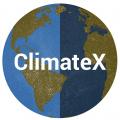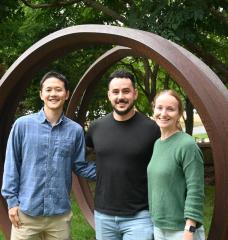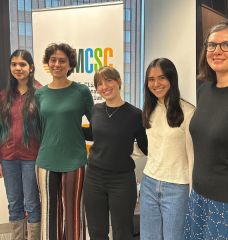
With so much climate misinformation out there, how do we teach the next generation the truth about climate change?
MIT Climate sat down with Kottie Christie-Blick, an elementary school teacher and climate change educational consultant. Her initiatives to design and implement climate change curriculum have been recognized by both the Nation Oceanic and Atmospheric Administration (NOAA) and the Fulbright Foundation. Kottie is also a NOAA Planet Stewards Educator and a Distinguished Fulbright teacher. She and her students were invited to meet with UN Secretary-General Ban Ki-Moon to discuss climate change and its impact on future generations.
We discussed climate literacy, children’s activism, and pushing back against climate skepticism. If you want to learn more about her work, check out her website Kids Against Climate Change for educational resources.
Mikaela: Why is it important to teach your students about climate change?
Kottie: Climate change is a scientific issue, but it’s now also a societal issue as people around the world begin feeling its impact. It’s important to both educate and empower children. Educate them, because they need to know what’s going on. This is their world and they need to be prepared for it. If we teachers can help kids learn about climate change, even if it’s just on a very basic level, more of them will begin recycling at home and turning off lights, and encouraging their parents to be mindful of waste. Their quality of life depends on actions we all take now.
I teach fifth graders – 10 year olds. I know some adults think elementary students are too young to learn about climate change. But I would argue the opposite. It would be negligent for us to avoid the topic. As teachers, we deal with the immediacy of the present, but we always have an eye on the future. It’s our duty, and our privilege, to help prepare children for their future. That’s what we do every day. It’s both exhausting and rewarding….every day!
Mikaela: What are some teaching tools you use to teach kids about global warming and climate change?
Kottie: My “go to” website is Kids Against Climate Change. My students and I created it a few years ago, and we’re keeping it up to date with great resources for teachers and students. The site also serves as a motivator for students, as kids can talk to other kids about climate change on the blog. Knowing that they’re going to be joining the online discussion keeps the students paying attention in class. They want to have information and opinions to add to the conversation.
Whenever possible, I utilize hands-on learning in the classroom. I start the lesson with a phenomenon that will really engage the children, for example, videos of ice melting in Antarctica and massive chunks of ice calving and falling into the ocean. I then ask why it’s happening. “What’s the science behind it? How could you create a model to better understand the phenomenon? Where can you find reliable information to better understand the causes and effects?” Instead of just memorizing information to get a good grade on a test, the students complete a real-world project or study a problem.

As a result of their research and lessons, the children may end up planting trees on school property or in their local area, or they may sponsor a local recycling initiative to increase recycling, or they may convince their families to track and then reduce their energy use. Although these actions, by themselves, are small steps for a big problem, when teachers share these project ideas with other teachers via social media, publication in educational magazines, or presentations at educational conferences, their influence is scaled up. Children, and their work, can be a positive force for change. My students don’t seem discouraged about climate change. They think the classroom activities are fun, they’re excited to share their information with others, and they’re full of confidence that they can slow it down.
Mikaela: Tell us about the Kids Against Climate Change website. How did the idea come up? What have the impacts been?
Kottie: The Kids Against Climate Change website started a couple of years ago with my students. They wanted to get the word out to other kids. We started to build this website with the children’s artistic renditions of climate change and their concerns and ideas on the blog. It’s really a “by kids for kids” website and blog – the only one of its kind that’s open to all kids, completely free, no registration, and no advertisements. I moderate comments to make sure that all contributions are appropriate for children.
Each year, my new crop of 5th graders is introduced to the site and develops a sense of ownership. The students check it, and add drawings, videos, and comments. They read what other kids have posted on the blog. Children have also told me that working on the site makes them feel like they’re part of something bigger than themselves – it’s encouraging and empowering.

We’re hoping Kids Against Climate Change will keep growing. Our vision is for kids around the world to use it as a platform to talk to each other about climate change – their concerns, as well as what actions they are taking. So please tell your favorite teachers about our site!
Mikaela: You and your fifth-grade students met with the UN Secretary-General Ban Ki-Moon. Tell us the story.
Kottie: A few years ago, my students were invited to meet with Secretary-General Ban Ki-moon at United Nations Headquarters in New York City. We had a private half-hour meeting with him, so they could congratulate him on the Paris Accord, and remind him not to forget about the children. They talked to him about the steps they were taking to mitigate climate change. Secretary-General, in all his graciousness, thanked the children and told them how inspiring it was to hear from them. He said that all day long he hears people telling him why they can’t. He said he felt encouraged to hear from this group of kids who said, “Yes, we CAN make changes to slow down climate change.”

My students were also very inspired by this powerful man who took their concerns about climate change seriously. They promised Secretary-General that they would continue to spread the word. As my student, Brian, told Secretary-General, “We may be small, but there are a lot of us. And we love to talk.” And they do!
When we teachers help children understand climate change, and help them internalize the importance of this scientific phenomenon, they begin talking to others. This is perhaps their greatest power. They can get the conversation started inside homes of those adults who may not want to think about climate change seriously because they don’t want it to be real. I know my students take it right to the family dinner table.
I think that educators don’t really understand that they are in a unique position right now to affect societal change. They don’t understand that they have the power, right now at this point in history, to increase society’s understanding of this scientific phenomenon that’s affecting societies. If kids can understand the basic causes and effects of climate change, then it’s just one more step to start taking action to slow it down.
Mikaela: Have parents been receptive to climate change curriculum?
Kottie: I haven’t had any pushback from parents. But sometimes I get a child who tells me, “My dad doesn’t believe in global warming.” That’s quite tricky for a teacher, as the entire class is listening for the response. I had another student who declared, “My uncle says Earth is not warming. He’s the smartest man I know, so I’m not sure how to think about what we’ve been learning in science.” Again, over forty ears are listening in on this conversation. It’s important to handle these genuine concerns and confusions gently and respectfully, while making it clear that opinions don’t change scientific facts.
I asked if her uncle was a climatologist. She said he was a car mechanic. So I responded, “Well in that case, since he’s the smartest man you know, if my car breaks down, I definitely want to take it to him. But since global warming is out of his area of expertise, we need to listen to climatologists who are respected in their field. It makes sense to believe them over anybody in any other field. Don’t you agree?” She agreed that that made sense.
Mikaela: If you had a magic wand and could change one thing regarding the policies or practices that contribute to global warming, what would you do?
Kottie: If I could change anything, I would de-politicize climate change, and allow clarity of thought. It’s not about politics, and it can’t be claimed by one party or another. It’s not valid to say I believe it or I don’t believe it. It’s just science. And because this scientific phenomenon impacts people’s lives, it’s now a societal issue. So the more clearly we all understand how people are impacting the environment, and the need to mitigate and adapt, the better off we’ll be, and the better off our children will be as they prepare for their future. Teachers, it’s time to start teaching climate science.






